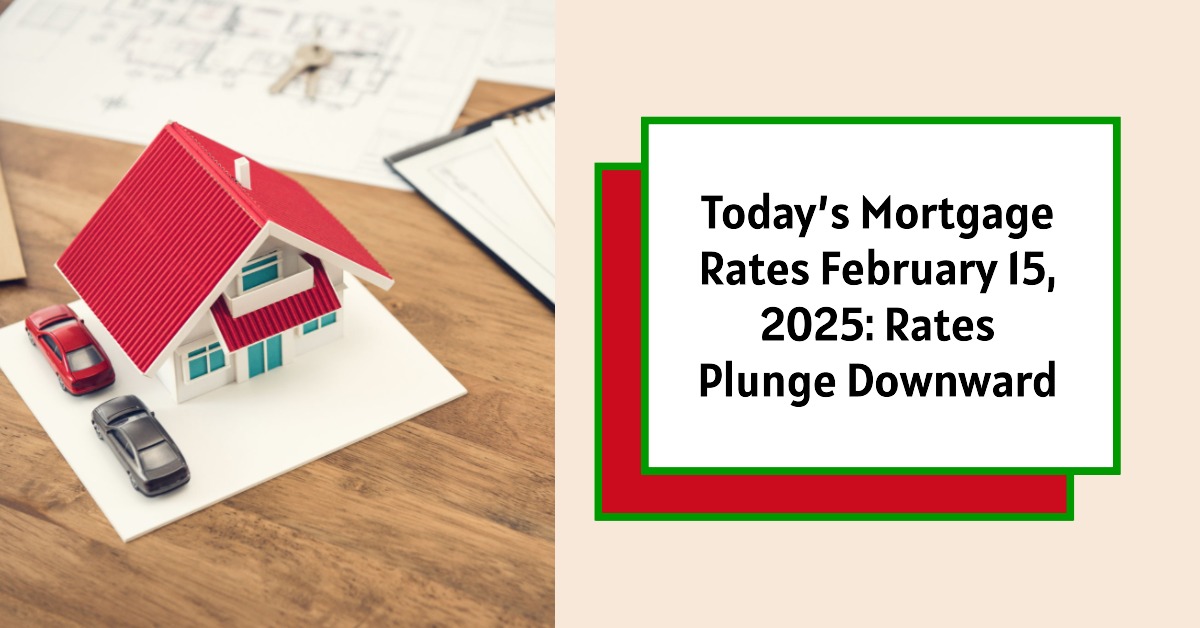As of February 15, 2025, today's mortgage rates have experienced a slight decline, with the average 30-year fixed mortgage rate at 6.53%, down nine basis points from the previous day. Similarly, the 15-year fixed mortgage rate fell to 5.87%, showing a decrease of seven basis points. This downward trend suggests a good opportunity for potential homeowners looking to lock in favorable rates for home purchases or refinancing. The current rates offer a glimpse of hope for those navigating the housing market, which has been heavily influenced by fluctuating economic conditions over the past few years.
Today’s Mortgage Rates February 15, 2025: Rates Plunge Downward
Key Takeaways:
- The 30-year fixed mortgage rate dropped to 6.53%.
- The 15-year fixed mortgage rate is now 5.87%.
- Rate declines are more modest, indicating that substantial drops aren't expected soon.
- Ideal for locking in mortgage rates as market conditions slowly change.
Current Mortgage Rates
According to Zillow, here are the updated mortgage rates as of today:
| Loan Type | Interest Rate |
|---|---|
| 30-year fixed | 6.53% |
| 20-year fixed | 6.19% |
| 15-year fixed | 5.87% |
| 5/1 adjustable-rate (ARM) | 6.45% |
| 7/1 adjustable-rate (ARM) | 6.40% |
| 30-year VA | 5.98% |
| 15-year VA | 5.43% |
| 5/1 VA | 6.05% |
| 30-year FHA | 5.75% |
| 15-year FHA | 5.25% |
These numbers are national averages and can vary by location, lender, and individual financial situation.
Today's Mortgage Refinance Rates
Mortgage refinance rates are typically slightly higher than home purchase rates. Here’s an overview of the current refinance rates:
| Loan Type | Interest Rate |
|---|---|
| 30-year fixed | 6.57% |
| 20-year fixed | 6.25% |
| 15-year fixed | 5.91% |
| 5/1 ARM | 6.51% |
| 7/1 ARM | 6.46% |
| 30-year VA | 5.92% |
| 15-year VA | 5.52% |
| 5/1 VA | 5.90% |
| 30-year FHA | 6.35% |
| 15-year FHA | 6.00% |
Refinancing can be an effective way to reduce your monthly payment if current rates are lower compared to your existing mortgage, or if you want to switch from an adjustable to a fixed-rate mortgage. Many individuals choose to refinance to take advantage of lower rates or to change the duration of their loans, potentially saving significant amounts over time.
Monthly Payments on Various Mortgage Amounts
Understanding how much your mortgage payment will be based on your loan amount and interest rate is crucial in budgeting for your future home. Below, I’ve calculated the monthly payments for several mortgage amounts based on the 30-year fixed rate of 6.53%.
Monthly Payment on $150,000 Mortgage
The monthly payment on a $150,000 mortgage at a rate of 6.53% would be approximately $948. This includes principal and interest but may not include taxes and insurance. Homeowners should factor these additional costs into their monthly budgets, as they can significantly increase total expenses.
Monthly Payment on $200,000 Mortgage
For a mortgage of $200,000, the estimated monthly payment at the same rate is around $1,264. This amount reflects the increase in liability as the loan quantity rises. An important aspect to consider with larger loans is the overall financial responsibility, which can impact future financial decisions.
Monthly Payment on $300,000 Mortgage
If you are looking at a $300,000 mortgage, expect to pay about $1,896 each month. As larger mortgages naturally lead to increased monthly commitments, consider how this might fit into your long-term financial plan without stretching your budget too thin.
Monthly Payment on $400,000 Mortgage
For a $400,000 mortgage, your monthly payment would be approximately $2,528. This payment level illustrates how crucial it is to thoroughly understand your financial boundaries. Prospective homebuyers should also consider how their income might project forward in the coming years as they assess the feasibility of larger loans.
Monthly Payment on $500,000 Mortgage
Lastly, for a $500,000 mortgage, the payment would hover around $3,185. This figure highlights the monetary commitment involved in homeownership and illustrates how financial decisions during the home-buying process can impact one’s lifestyle and comfort levels.
| Mortgage Amount | Monthly Payment |
|---|---|
| $150,000 | $948 |
| $200,000 | $1,264 |
| $300,000 | $1,896 |
| $400,000 | $2,528 |
| $500,000 | $3,185 |
These calculations help illustrate the potential financial burden of mortgage payments at current interest rates, allowing potential buyers to make informed choices.
Recommended Read:
Mortgage Rates Trends as of February 14, 2025
Will Mortgage Rates Rise Back Above 7% or Go Down in 2025?
Mortgage Rate Predictions for February 2025: Will Rates Drop?
What Influences Mortgage Rates Today?
Mortgage rates are influenced by a variety of factors:
- Federal Reserve Policy: When the Fed changes interest rates, it has a direct impact on mortgage rates. Recently, the Fed has been cautious about rapid increases, focusing on stability over drastic changes. Understanding the Fed’s economic strategies gives potential homeowners insight into future mortgage rate trends, as these actions directly impact borrowing costs.
- Economic Indicators: Inflation data, job reports, and other economic indicators can lead to adjustments in interest rates. For example, a strong jobs report often signals a growing economy, which may lead to higher interest rates as demand for borrowing increases. Conversely, poor economic news can result in lower rates.
- Supply and Demand: If more people want to buy homes than there are available homes, prices and sometimes rates tend to increase. In competitive housing markets, favorable interest rates can become scarce as demand outpaces supply, making it ever more critical for buyers to act swiftly when they find good lending terms.
- Global Economic Conditions: Factors beyond U.S. borders can also impact mortgage rates. International events that impact oil prices, trade agreements, and geopolitical tensions can affect the economic landscape, creating a ripple effect that influences interest rates at home.
The Broader Economic Climate and Housing Market Context
Understanding mortgage rates also means looking at the broader economic climate and housing market context. Over the last few years, the housing market has experienced rapid price increases and high demand, but there are signs of stabilization.
Home Prices: Although the general trend in real estate prices had been upward during the pandemic, there are indications of a cooling market. Recent data suggests that home prices have stabilized, providing opportunities for buyers to explore the market without the overwhelming competition that characterized previous years.
Buyer Sentiment: Current surveys of buyer sentiment indicate a cautious optimism. Many potential buyers are weighing their options as they consider rates, prices, and their personal financial situations. This cautious mentality is also reflected in the decisions of many homeowners who are choosing to refinance existing loans or explore different financing options.
Economic Projections: Economists project that the overall economic growth may continue, but at a slower pace. It is vital to keep an eye on both local and national economic indicators, as these will help predict changes in housing demand and mortgage rates throughout 2025.
Looking Ahead: What To Expect?
While today marks a slight drop in mortgage rates, some analysts suggest that we shouldn’t expect dramatic decreases in the near future. Factors such as inflation and the Fed's policies will continue to play significant roles in determining the direction of these rates.
Individuals looking to purchase homes or refinance existing mortgages will do well to keep an eye on these trends in the coming months. Every small change can significantly impact the overall cost of a mortgage. Furthermore, market predictions indicate a possibility of moderate increases in mortgage rates as the year unfolds.
In this environment, potential homeowners should consider locking in lower rates sooner rather than later, as the current market conditions offer a more favorable climate compared to predictions of rising rates on the horizon.
Purchasing a home is a long-term commitment, so understanding today’s mortgage rates within the broader context of economic trends can empower buyers to make informed decisions that align with their financial goals.
Work with Norada in 2025, Your Trusted Source for
Real Estate Investing
With mortgage rates fluctuating, investing in turnkey real estate
can help you secure consistent returns.
Expand your portfolio confidently, even in a shifting interest rate environment.
Speak with our expert investment counselors (No Obligation):
(800) 611-3060
Recommended Read:
- Mortgage Rates Forecast for the Next 3 Years: 2025 to 2027
- 30-Year Mortgage Rate Forecast for the Next 5 Years
- 15-Year Mortgage Rate Forecast for the Next 5 Years
- Why Are Mortgage Rates Going Up in 2025: Will Rates Drop?
- Why Are Mortgage Rates So High and Predictions for 2025
- NAR Predicts 6% Mortgage Rates in 2025 Will Boost Housing Market
- Mortgage Rates Predictions for 2025: Expert Forecast
- Will Mortgage Rates Ever Be 3% Again: Future Outlook
- Mortgage Rates Predictions for Next 2 Years
- Mortgage Rate Predictions for Next 5 Years
- Mortgage Rate Predictions for 2025: Expert Forecast
- Mortgage Rate Predictions: Why 2% and 3% Rates are Out of Reach
- How Lower Mortgage Rates Can Save You Thousands?
- How to Get a Low Mortgage Interest Rate?
- Will Mortgage Rates Ever Be 4% Again?



